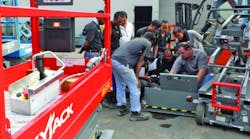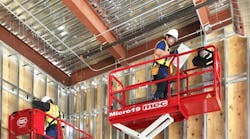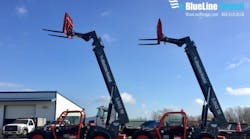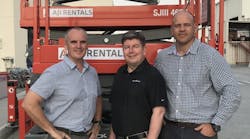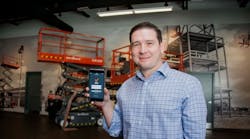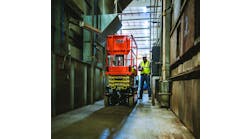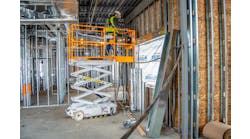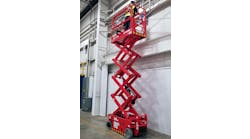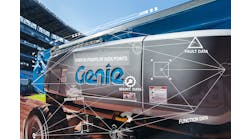Brad Boehler, president, Skyjack, talks about telematics, the future of autonomous machines, the impact of tariffs on the rental industry, new safety initiatives, international aerial growth, upcoming ANSI standards and more.
RER: What are some of the new developments technologically in your company’s equipment during the past year?
Boehler: The standout development was the launch of Elevate – our Telematics package. We planned to launch at The Rental Show in New Orleans, but news of what we were up to leaked out and we ended up launching with commitments of 7,000 units for delivery in 2018 before we really started promoting. We were so successful because we had spent a lot of time talking to customers and, in reality, had to re-invent telematics for the rental industry, rather than trying to force a typical (on-road based) model on to off-highway machines. So, not the most information but the most important information -- a mobile-first philosophy for a very mobile industry, tailored and optimized to provide features unique to Skyjack equipment...all at a price that made sense for a 19-foot scissor lift to a 12,00-pound telehandler.
RER: What trends do you see on the horizon with your company’s equipment, and the industry as a whole?
Boehler: I would start with Elevate. Our approach has led to much thought on predictive maintenance, true battery management techniques, better understanding of user applications and other value-added benefits. We are also actively looking at new power sources for our machines, so configurations like electric drive, hybrids and other environmental or efficiency gains are under intense study. While some of these are not the cutting edge of technology in general, as a company focused on the rental industry we have always looked to take any technology and mold it into pragmatic solutions for those customers, both in terms of performance and cost. As a final point, I am on record of challenging my team to bring functional autonomous machines to market by 2023 and we have a roadmap within our Innovation team to accomplish this task.
RER: The price of materials is rising with the recent implementation of tariffs from the Trump administration and by other countries in response. How big an impact will this have on manufacturing and on demand for aerial equipment in the marketplace?
Boehler: Our industry is being impacted on a variety of fronts related to trade. Material costs are rising and to be blunt, they are rising sharply, to the point where they can no longer be contained within the current OEM cost structure. Rental companies will be negatively affected. At Skyjack we have contained price pressures to date and not taken immediate, “knee jerk” reactions. I tend to think others should have done so as well. Announcing pricing increases and steel surcharges, before the tariff were enacted casts all OEMs in a bad light of being opportunistic and greedy. However, with the supporting facts coming forward, I see a time in the near future where an appropriate pricing response from Skyjack is rational and necessary.
As far as tariffs are concerned, I am a firm believer in globalization and that the way to “protect” an industry is to encourage it to help itself to become productive, efficient and effective. Artificial methods such as tariffs really just cement the status quo and incent poor commercial behaviour within the industry you wish to protect.
Looking at it another way, the U.S. has announced the intent for a substantial infrastructure bill. It is likely that there is not enough construction equipment to support the bill’s aspirations...yet tariffs have at best added a significant cost increase to both the machinery and the project materials, jeopardizing the outcome of the legislation completely.
Ultimately, coming back to the question, both material cost and tariffs will certainly have an impact on rental companies.
RER: Safety continues to be an important topic in the aerial industry. What are some of the new safety developments on your company’s equipment and do you see any new developments on the horizon?
Boehler: Given my background as a product safety engineer, this subject is always on the top of my mind and Skyjack’s agenda. The provision of some secondary guarding scissors is very topical. The reality is no one solution fits all applications and as always, safe use has to rely on risk assessment that conforms to appropriate use of any lift. However, we are offering options to allow for warning and protecting operators in different situations.
This year we launched a product called SGLE to allow for secondary guarding on scissors where appropriate as defined by an appropriate risk assessment.
SGLE – Secondary Guarding Lift Enable. Both the joystick and the tamper proof secondary enable switch must be activated to allow the platform to lift (release of either will stop the function immediately). The ergonomics are such that the operator’s body is kept in an upright position and away from the railings; mitigating the risk of entrapment. The secondary enable button is not required for lowering the platform or for driving; those functions are joystick enable controlled only. SGLE is suitable for all Skyjack scissor lift and vertical mast lift models and is available as a direct factory install or aftermarket accessory.
In addition, we exhibited a concept of our PPA at The Rental Show this year. The customer comments were favorable and we are now moving forward on that with some suggested improvements.
PPA—Platform Proximity Alert - A series of ultrasonic rail mounted sensors integrated in the scissors control system that provides a warning visual and audible signal when an obstruction comes within a certain distance. The operator can elevate through this level until an additional alarm is triggered as the obstruction comes closer. At this second level the unit will stop, though the operator can override (after checking the situation around them) by resetting the joystick....an alarm will continue to sound and alert the operator to the proximity of the obstruction.
We anticipate two versions of PPA...
- Operator Zone version where the sensor array monitors the area above and around the operator
- Full Platform Zone version where the sensor array monitors the area above and around the entire platform.
In general safety terms we did take the initiative early in the year to publish a white paper that guides the reader through the initiatives Skyjack have completed and will be undertaking...
http://skyjack.com/sites/default/files/specifications/PDF/SKYJACK-SAFETY-INITIATIVES.pdf
The international demand for aerial equipment continues to grow as people in different countries and industries become more aware of the benefits of aerial equipment. What might be some of the breakthrough areas in usage of aerials in the foreseeable future?
Boehler: For some time, we have talked about Asia and more specifically China. While the statistics on growth are impressive the actual volume is low in comparison with other areas. Commentators have often claimed that in five years it could be “massive”, however I fell we have been saving that for seven to 10 years! I am not sure the market is quite ready to explode there yet. To me the key is the adoption of the rental business model in a market where ownership is the preference and even then, other construction, industrial and regulatory changes will have to take place for the Chinese market to grow to meaningful volume levels (my thought is that is growing exponentially now, the issue is the low volume start).
In general, usage of access and material handling equipment is becoming more commonplace around the globe and that increased acceptance should lead to continued increased demand and global growth of our markets.
New ANSI standards are expected to be published later this year. Can you summarize the impact the new standards will have on the aerial rental industry?
Boehler: The first and most immediate impact is that rental companies in the US are faced with a fleet buying decision. That’s one between existing designs on the one hand and new designs on the other. Following the standards publication OEMs have 12 months in which to begin to produce compliant designs. For Skyjack there will be a phased introduction over a variety of product lines. Assuming a prospective September 2018 publication of the series of standards, OEMs will no longer be able to manufacture machinery compliant too the previous standards after September 2019. Rental companies are going to have to work with their OEM suppliers to ensure uninterrupted supply of the appropriate equipment.
The new standards are being implemented to expand upon the design, usage and training requirements of the access industry and become more aligned with other global standards. The consequence of this is that it will bring new equipment to the market that will not perform in the same way as the machines beside them. The responsibilities regarding the education end users to the changes in use and the impact for example of load sensing will now fall upon the rental companies. As an organisation this is why we introduced a white paper that explained those impacts...
http://skyjack.com/ansi-whitepaper
At Skyjack we realise that the rental industry will be faced with changes and costs, without the ability to demand higher rates. To mitigate this impact, we have added or improved features (beyond what the standard asks for) that should help our customers re-balance their ROI equation. Things like...
- Emergency lowering – simplified one step process
- Pot hole protection – simplified mechanism that is easier to service
- Stiffer scissor stack – improved stability and feel
- Sky-coded control – a new control system that retains the simple color code wire principle but also leads the way to telematics and more
- New control box – more durable material and better repair access
- Enhanced Capacity on Booms – to offset end user perception of new load controls
